Organizational Behaviour & Management: Intergroup Conflict Report
VerifiedAdded on 2023/06/11
|6
|1172
|114
Report
AI Summary
This research report provides an analysis of workplace situations involving intergroup conflicts, aiming to identify these conflicts and develop suitable solutions. It explores the nature and sources of conflict, including interpersonal issues like office politics, cultural differences, and organizational factors such as power differences and supervisory styles. The report suggests techniques to resolve conflicts, such as disciplinary actions, negotiation, collaboration, and mediation, evaluating the effectiveness of these approaches. It emphasizes the importance of stringent ethical principles and norms in managing conflict to maintain work productivity and employee morale, highlighting the role of HR in implementing policies and supervising disciplinary actions to avoid unnecessary conflicts.
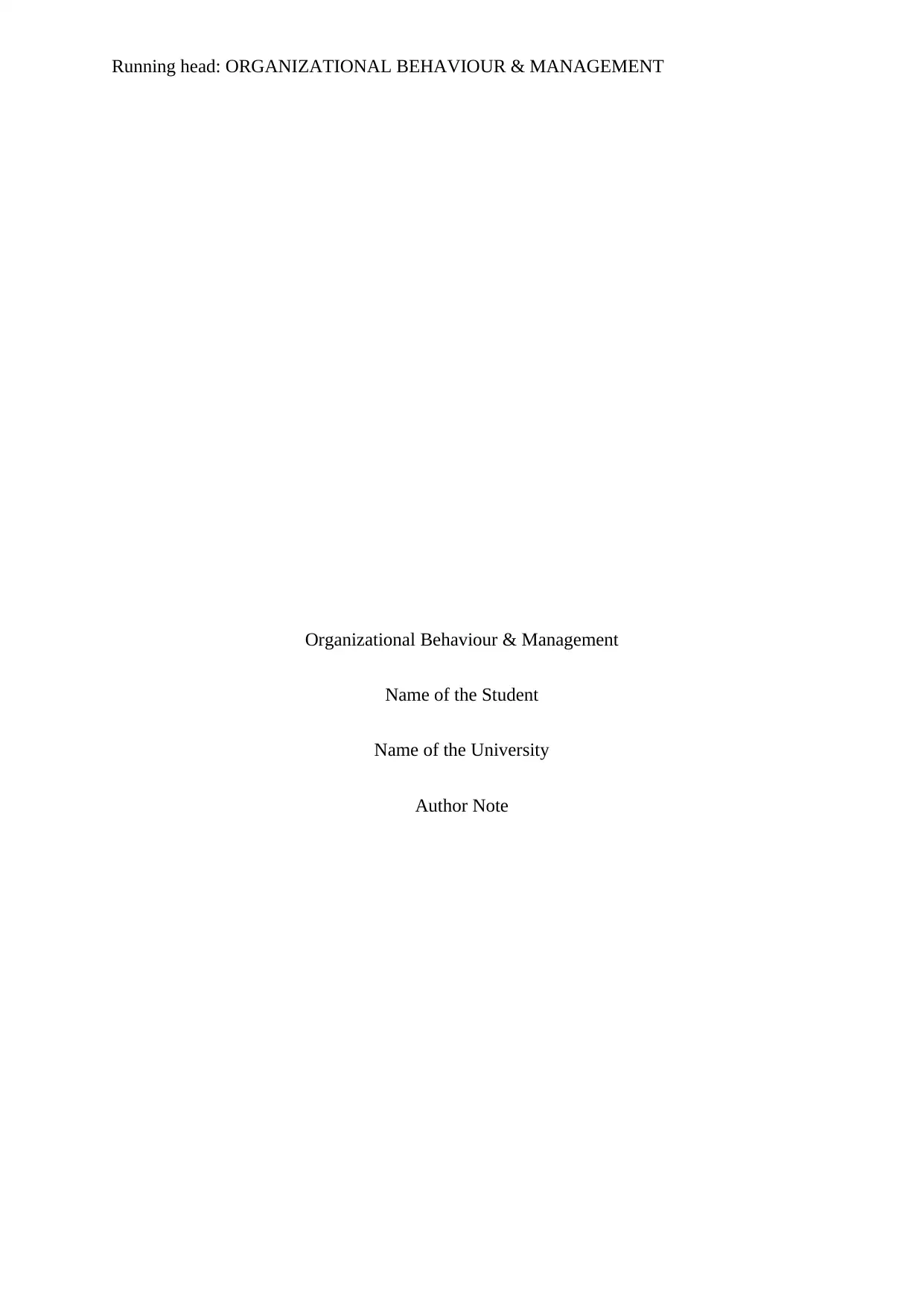
Running head: ORGANIZATIONAL BEHAVIOUR & MANAGEMENT
Organizational Behaviour & Management
Name of the Student
Name of the University
Author Note
Organizational Behaviour & Management
Name of the Student
Name of the University
Author Note
Paraphrase This Document
Need a fresh take? Get an instant paraphrase of this document with our AI Paraphraser
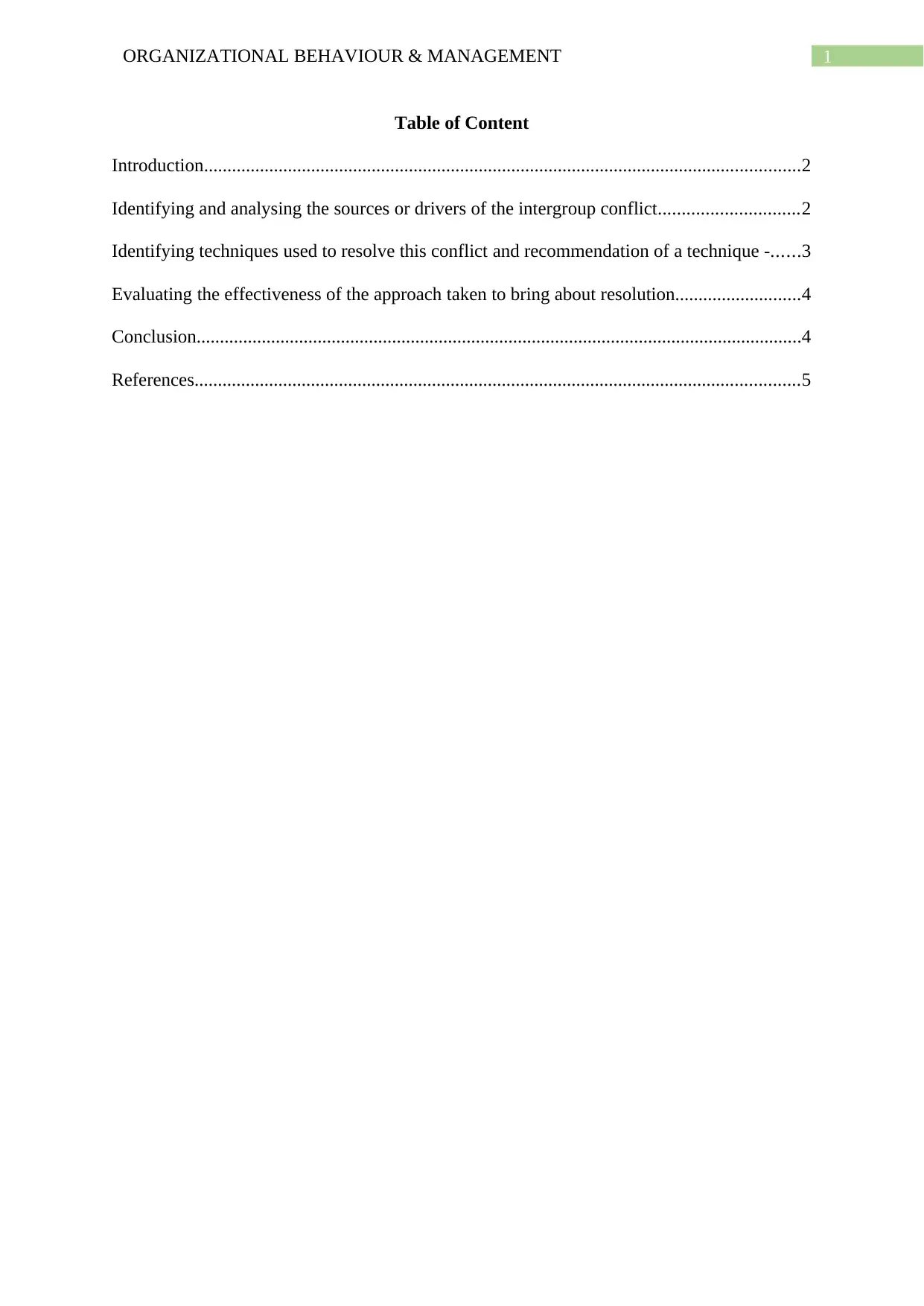
1ORGANIZATIONAL BEHAVIOUR & MANAGEMENT
Table of Content
Introduction................................................................................................................................2
Identifying and analysing the sources or drivers of the intergroup conflict..............................2
Identifying techniques used to resolve this conflict and recommendation of a technique -......3
Evaluating the effectiveness of the approach taken to bring about resolution...........................4
Conclusion..................................................................................................................................4
References..................................................................................................................................5
Table of Content
Introduction................................................................................................................................2
Identifying and analysing the sources or drivers of the intergroup conflict..............................2
Identifying techniques used to resolve this conflict and recommendation of a technique -......3
Evaluating the effectiveness of the approach taken to bring about resolution...........................4
Conclusion..................................................................................................................................4
References..................................................................................................................................5
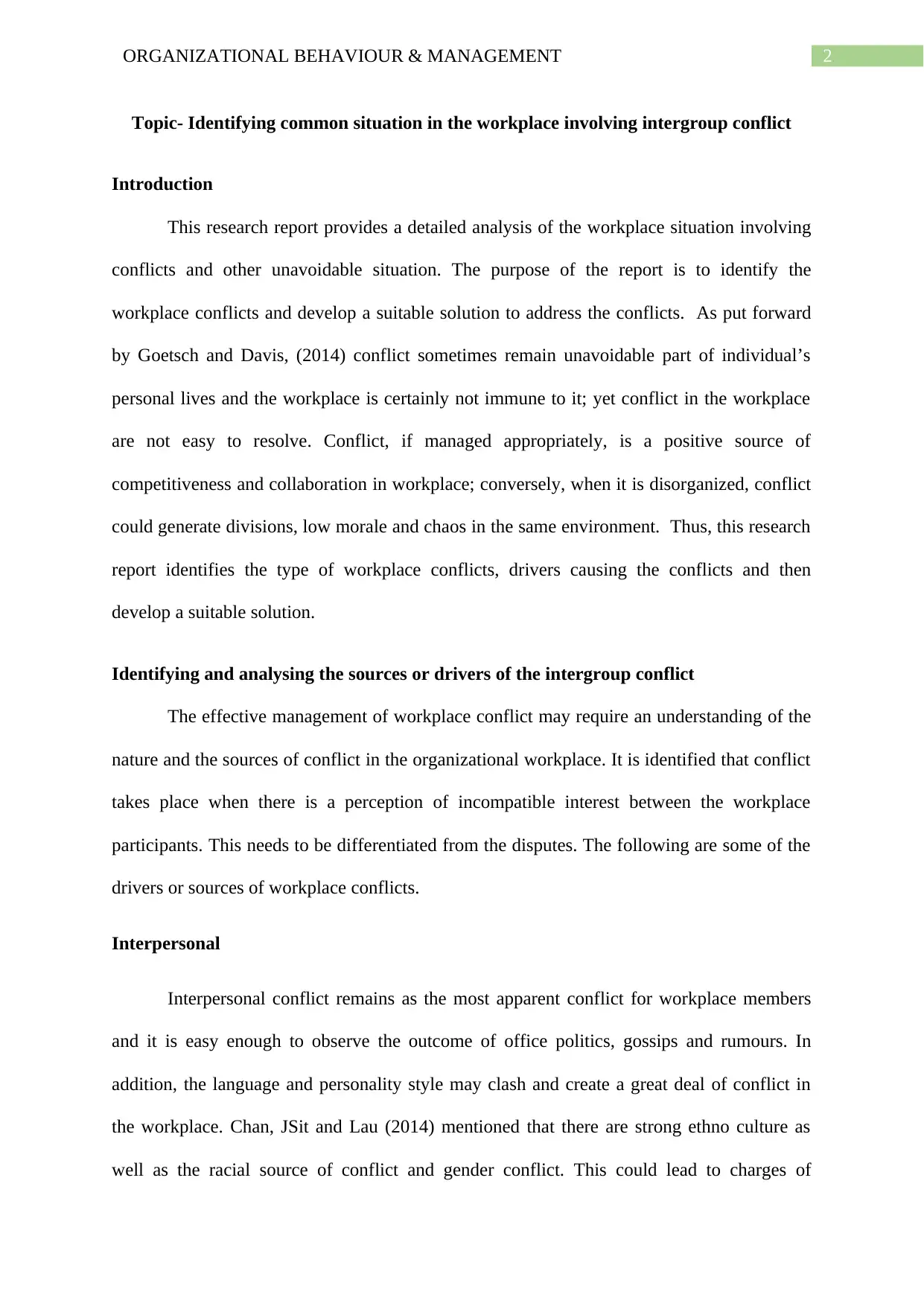
2ORGANIZATIONAL BEHAVIOUR & MANAGEMENT
Topic- Identifying common situation in the workplace involving intergroup conflict
Introduction
This research report provides a detailed analysis of the workplace situation involving
conflicts and other unavoidable situation. The purpose of the report is to identify the
workplace conflicts and develop a suitable solution to address the conflicts. As put forward
by Goetsch and Davis, (2014) conflict sometimes remain unavoidable part of individual’s
personal lives and the workplace is certainly not immune to it; yet conflict in the workplace
are not easy to resolve. Conflict, if managed appropriately, is a positive source of
competitiveness and collaboration in workplace; conversely, when it is disorganized, conflict
could generate divisions, low morale and chaos in the same environment. Thus, this research
report identifies the type of workplace conflicts, drivers causing the conflicts and then
develop a suitable solution.
Identifying and analysing the sources or drivers of the intergroup conflict
The effective management of workplace conflict may require an understanding of the
nature and the sources of conflict in the organizational workplace. It is identified that conflict
takes place when there is a perception of incompatible interest between the workplace
participants. This needs to be differentiated from the disputes. The following are some of the
drivers or sources of workplace conflicts.
Interpersonal
Interpersonal conflict remains as the most apparent conflict for workplace members
and it is easy enough to observe the outcome of office politics, gossips and rumours. In
addition, the language and personality style may clash and create a great deal of conflict in
the workplace. Chan, JSit and Lau (2014) mentioned that there are strong ethno culture as
well as the racial source of conflict and gender conflict. This could lead to charges of
Topic- Identifying common situation in the workplace involving intergroup conflict
Introduction
This research report provides a detailed analysis of the workplace situation involving
conflicts and other unavoidable situation. The purpose of the report is to identify the
workplace conflicts and develop a suitable solution to address the conflicts. As put forward
by Goetsch and Davis, (2014) conflict sometimes remain unavoidable part of individual’s
personal lives and the workplace is certainly not immune to it; yet conflict in the workplace
are not easy to resolve. Conflict, if managed appropriately, is a positive source of
competitiveness and collaboration in workplace; conversely, when it is disorganized, conflict
could generate divisions, low morale and chaos in the same environment. Thus, this research
report identifies the type of workplace conflicts, drivers causing the conflicts and then
develop a suitable solution.
Identifying and analysing the sources or drivers of the intergroup conflict
The effective management of workplace conflict may require an understanding of the
nature and the sources of conflict in the organizational workplace. It is identified that conflict
takes place when there is a perception of incompatible interest between the workplace
participants. This needs to be differentiated from the disputes. The following are some of the
drivers or sources of workplace conflicts.
Interpersonal
Interpersonal conflict remains as the most apparent conflict for workplace members
and it is easy enough to observe the outcome of office politics, gossips and rumours. In
addition, the language and personality style may clash and create a great deal of conflict in
the workplace. Chan, JSit and Lau (2014) mentioned that there are strong ethno culture as
well as the racial source of conflict and gender conflict. This could lead to charges of
⊘ This is a preview!⊘
Do you want full access?
Subscribe today to unlock all pages.

Trusted by 1+ million students worldwide
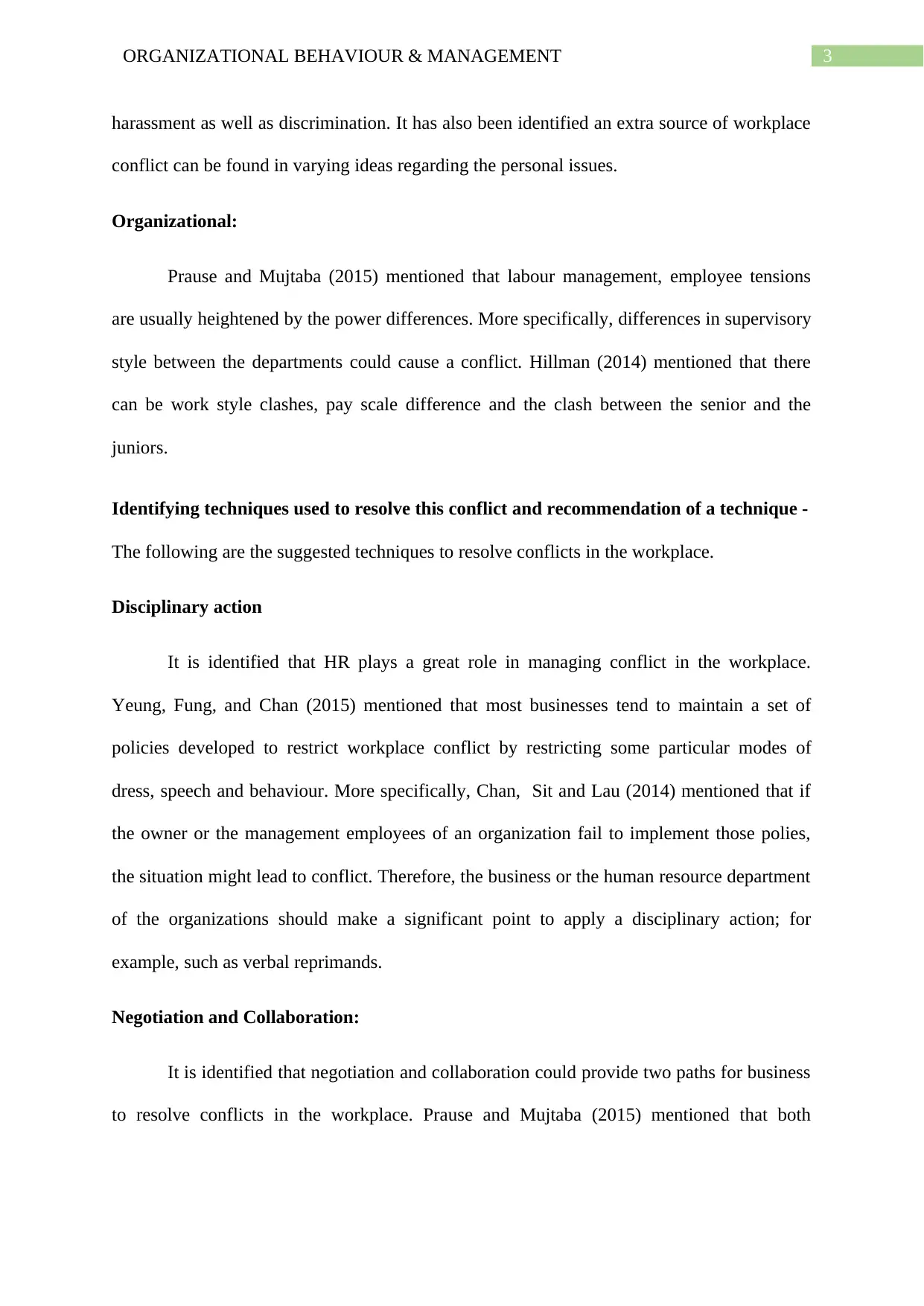
3ORGANIZATIONAL BEHAVIOUR & MANAGEMENT
harassment as well as discrimination. It has also been identified an extra source of workplace
conflict can be found in varying ideas regarding the personal issues.
Organizational:
Prause and Mujtaba (2015) mentioned that labour management, employee tensions
are usually heightened by the power differences. More specifically, differences in supervisory
style between the departments could cause a conflict. Hillman (2014) mentioned that there
can be work style clashes, pay scale difference and the clash between the senior and the
juniors.
Identifying techniques used to resolve this conflict and recommendation of a technique -
The following are the suggested techniques to resolve conflicts in the workplace.
Disciplinary action
It is identified that HR plays a great role in managing conflict in the workplace.
Yeung, Fung, and Chan (2015) mentioned that most businesses tend to maintain a set of
policies developed to restrict workplace conflict by restricting some particular modes of
dress, speech and behaviour. More specifically, Chan, Sit and Lau (2014) mentioned that if
the owner or the management employees of an organization fail to implement those polies,
the situation might lead to conflict. Therefore, the business or the human resource department
of the organizations should make a significant point to apply a disciplinary action; for
example, such as verbal reprimands.
Negotiation and Collaboration:
It is identified that negotiation and collaboration could provide two paths for business
to resolve conflicts in the workplace. Prause and Mujtaba (2015) mentioned that both
harassment as well as discrimination. It has also been identified an extra source of workplace
conflict can be found in varying ideas regarding the personal issues.
Organizational:
Prause and Mujtaba (2015) mentioned that labour management, employee tensions
are usually heightened by the power differences. More specifically, differences in supervisory
style between the departments could cause a conflict. Hillman (2014) mentioned that there
can be work style clashes, pay scale difference and the clash between the senior and the
juniors.
Identifying techniques used to resolve this conflict and recommendation of a technique -
The following are the suggested techniques to resolve conflicts in the workplace.
Disciplinary action
It is identified that HR plays a great role in managing conflict in the workplace.
Yeung, Fung, and Chan (2015) mentioned that most businesses tend to maintain a set of
policies developed to restrict workplace conflict by restricting some particular modes of
dress, speech and behaviour. More specifically, Chan, Sit and Lau (2014) mentioned that if
the owner or the management employees of an organization fail to implement those polies,
the situation might lead to conflict. Therefore, the business or the human resource department
of the organizations should make a significant point to apply a disciplinary action; for
example, such as verbal reprimands.
Negotiation and Collaboration:
It is identified that negotiation and collaboration could provide two paths for business
to resolve conflicts in the workplace. Prause and Mujtaba (2015) mentioned that both
Paraphrase This Document
Need a fresh take? Get an instant paraphrase of this document with our AI Paraphraser
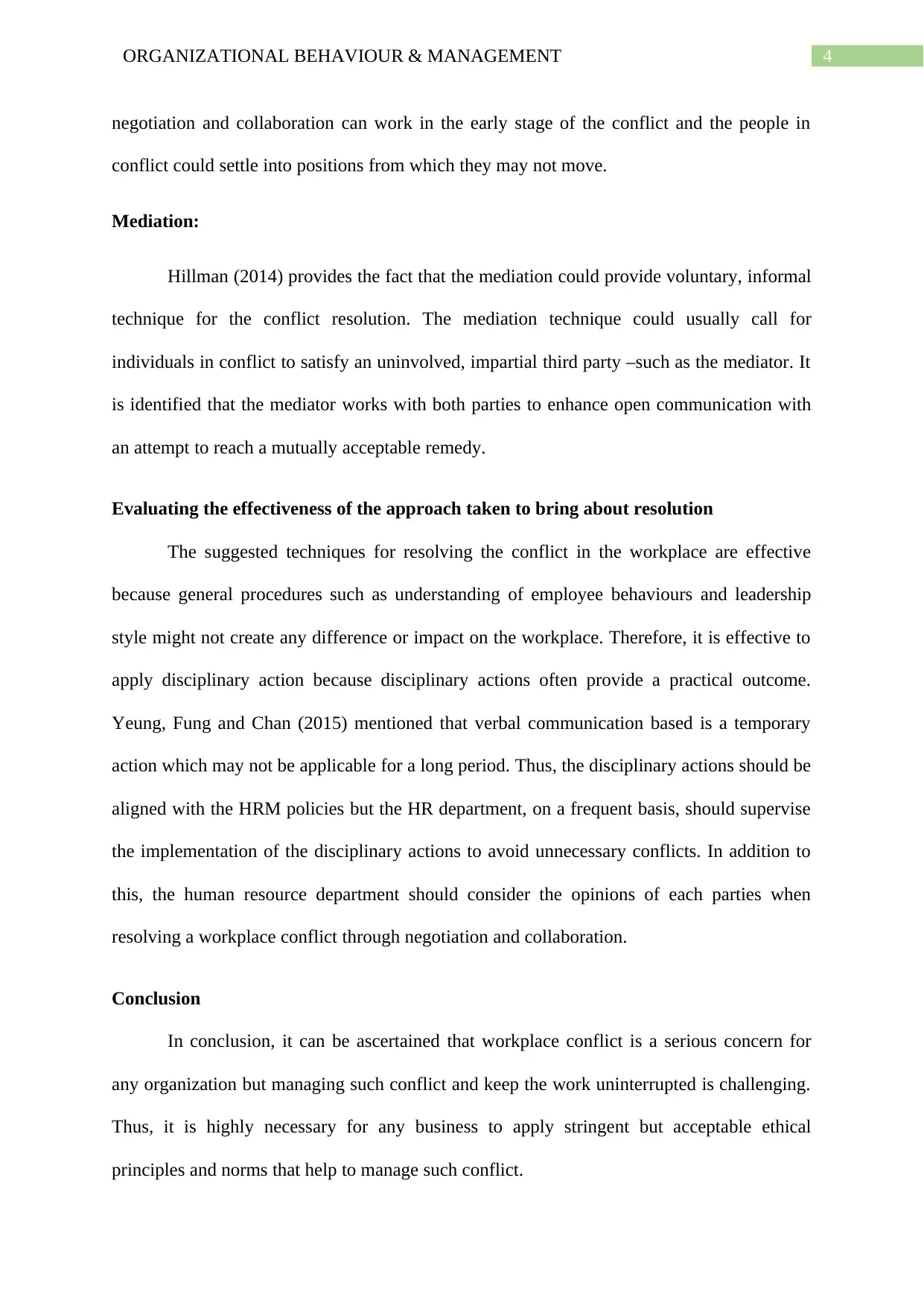
4ORGANIZATIONAL BEHAVIOUR & MANAGEMENT
negotiation and collaboration can work in the early stage of the conflict and the people in
conflict could settle into positions from which they may not move.
Mediation:
Hillman (2014) provides the fact that the mediation could provide voluntary, informal
technique for the conflict resolution. The mediation technique could usually call for
individuals in conflict to satisfy an uninvolved, impartial third party –such as the mediator. It
is identified that the mediator works with both parties to enhance open communication with
an attempt to reach a mutually acceptable remedy.
Evaluating the effectiveness of the approach taken to bring about resolution
The suggested techniques for resolving the conflict in the workplace are effective
because general procedures such as understanding of employee behaviours and leadership
style might not create any difference or impact on the workplace. Therefore, it is effective to
apply disciplinary action because disciplinary actions often provide a practical outcome.
Yeung, Fung and Chan (2015) mentioned that verbal communication based is a temporary
action which may not be applicable for a long period. Thus, the disciplinary actions should be
aligned with the HRM policies but the HR department, on a frequent basis, should supervise
the implementation of the disciplinary actions to avoid unnecessary conflicts. In addition to
this, the human resource department should consider the opinions of each parties when
resolving a workplace conflict through negotiation and collaboration.
Conclusion
In conclusion, it can be ascertained that workplace conflict is a serious concern for
any organization but managing such conflict and keep the work uninterrupted is challenging.
Thus, it is highly necessary for any business to apply stringent but acceptable ethical
principles and norms that help to manage such conflict.
negotiation and collaboration can work in the early stage of the conflict and the people in
conflict could settle into positions from which they may not move.
Mediation:
Hillman (2014) provides the fact that the mediation could provide voluntary, informal
technique for the conflict resolution. The mediation technique could usually call for
individuals in conflict to satisfy an uninvolved, impartial third party –such as the mediator. It
is identified that the mediator works with both parties to enhance open communication with
an attempt to reach a mutually acceptable remedy.
Evaluating the effectiveness of the approach taken to bring about resolution
The suggested techniques for resolving the conflict in the workplace are effective
because general procedures such as understanding of employee behaviours and leadership
style might not create any difference or impact on the workplace. Therefore, it is effective to
apply disciplinary action because disciplinary actions often provide a practical outcome.
Yeung, Fung and Chan (2015) mentioned that verbal communication based is a temporary
action which may not be applicable for a long period. Thus, the disciplinary actions should be
aligned with the HRM policies but the HR department, on a frequent basis, should supervise
the implementation of the disciplinary actions to avoid unnecessary conflicts. In addition to
this, the human resource department should consider the opinions of each parties when
resolving a workplace conflict through negotiation and collaboration.
Conclusion
In conclusion, it can be ascertained that workplace conflict is a serious concern for
any organization but managing such conflict and keep the work uninterrupted is challenging.
Thus, it is highly necessary for any business to apply stringent but acceptable ethical
principles and norms that help to manage such conflict.
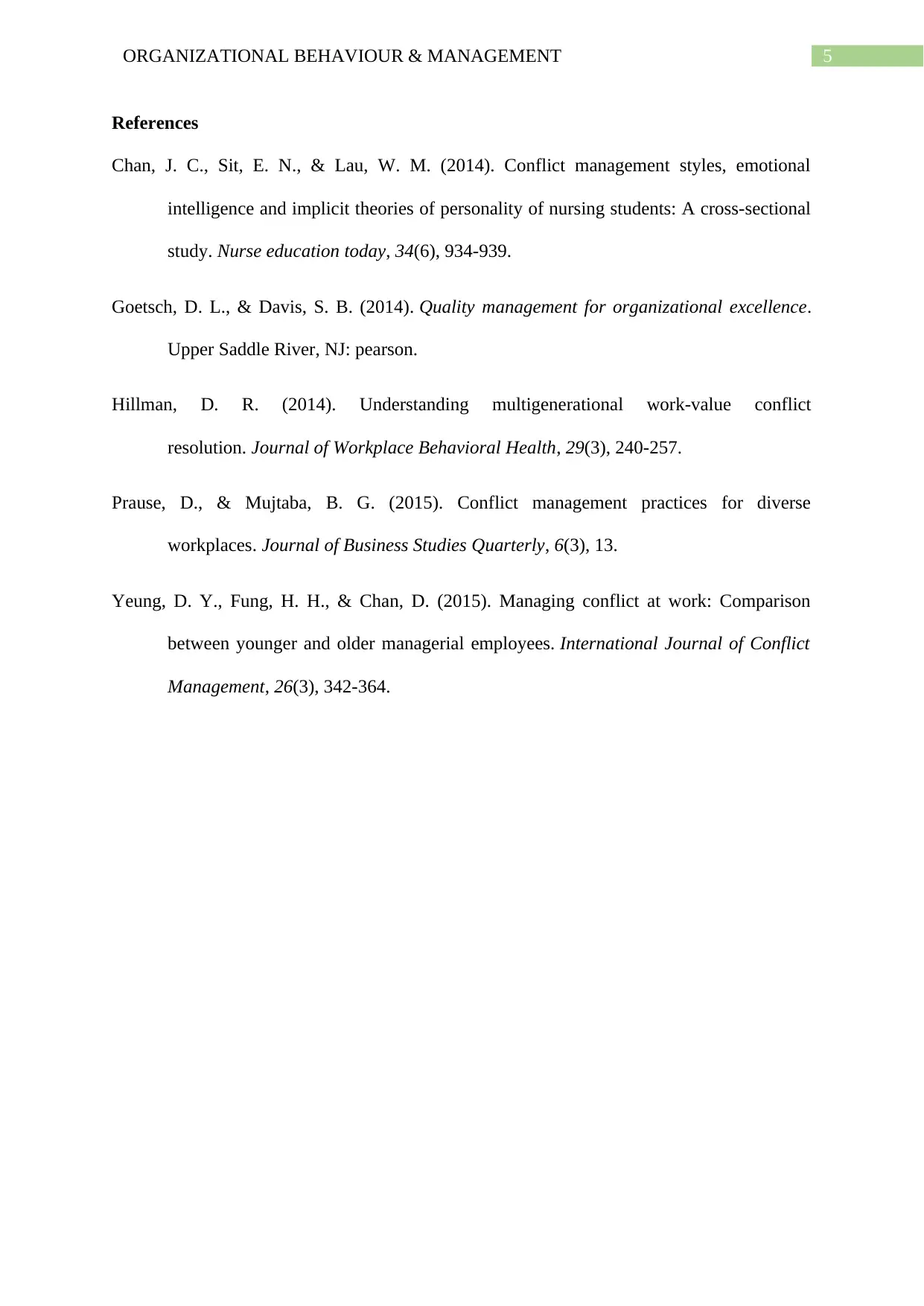
5ORGANIZATIONAL BEHAVIOUR & MANAGEMENT
References
Chan, J. C., Sit, E. N., & Lau, W. M. (2014). Conflict management styles, emotional
intelligence and implicit theories of personality of nursing students: A cross-sectional
study. Nurse education today, 34(6), 934-939.
Goetsch, D. L., & Davis, S. B. (2014). Quality management for organizational excellence.
Upper Saddle River, NJ: pearson.
Hillman, D. R. (2014). Understanding multigenerational work-value conflict
resolution. Journal of Workplace Behavioral Health, 29(3), 240-257.
Prause, D., & Mujtaba, B. G. (2015). Conflict management practices for diverse
workplaces. Journal of Business Studies Quarterly, 6(3), 13.
Yeung, D. Y., Fung, H. H., & Chan, D. (2015). Managing conflict at work: Comparison
between younger and older managerial employees. International Journal of Conflict
Management, 26(3), 342-364.
References
Chan, J. C., Sit, E. N., & Lau, W. M. (2014). Conflict management styles, emotional
intelligence and implicit theories of personality of nursing students: A cross-sectional
study. Nurse education today, 34(6), 934-939.
Goetsch, D. L., & Davis, S. B. (2014). Quality management for organizational excellence.
Upper Saddle River, NJ: pearson.
Hillman, D. R. (2014). Understanding multigenerational work-value conflict
resolution. Journal of Workplace Behavioral Health, 29(3), 240-257.
Prause, D., & Mujtaba, B. G. (2015). Conflict management practices for diverse
workplaces. Journal of Business Studies Quarterly, 6(3), 13.
Yeung, D. Y., Fung, H. H., & Chan, D. (2015). Managing conflict at work: Comparison
between younger and older managerial employees. International Journal of Conflict
Management, 26(3), 342-364.
⊘ This is a preview!⊘
Do you want full access?
Subscribe today to unlock all pages.

Trusted by 1+ million students worldwide
1 out of 6
Related Documents
Your All-in-One AI-Powered Toolkit for Academic Success.
+13062052269
info@desklib.com
Available 24*7 on WhatsApp / Email
![[object Object]](/_next/static/media/star-bottom.7253800d.svg)
Unlock your academic potential
Copyright © 2020–2025 A2Z Services. All Rights Reserved. Developed and managed by ZUCOL.


